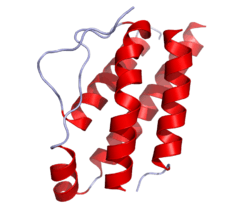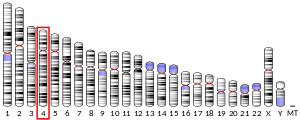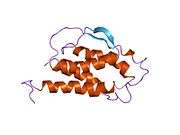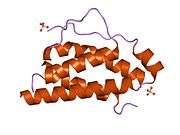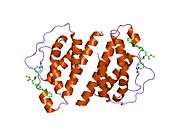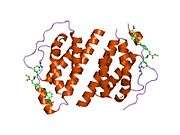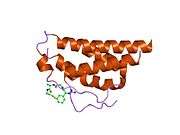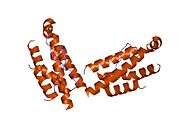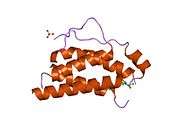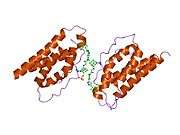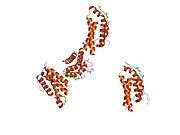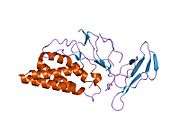Interleukin 2
Interleukin-2 (IL-2) is an interleukin, a type of cytokine signaling molecule in the immune system. It is a 15.5–16 kDa protein[5] that regulates the activities of white blood cells (leukocytes, often lymphocytes) that are responsible for immunity. IL-2 is part of the body's natural response to microbial infection, and in discriminating between foreign ("non-self") and "self". IL-2 mediates its effects by binding to IL-2 receptors, which are expressed by lymphocytes. The major sources of IL-2 are activated CD4+ T cells and activated CD8+ T cells.[6]
IL-2 receptor
IL-2 is a member of a cytokine family, each member of which has a four alpha helix bundle; the family also includes IL-4, IL-7, IL-9, IL-15 and IL-21. IL-2 signals through the IL-2 receptor, a complex consisting of three chains, termed alpha (CD25), beta (CD122) and gamma (CD132). The gamma chain is shared by all family members.[6]
The IL-2 receptor (IL-2R) α subunit binds IL-2 with low affinity (Kd~ 10−8 M). Interaction of IL-2 and CD25 alone does not lead to signal transduction due to its short intracellular chain but has the ability (when bound to the β and γ subunit) to increase the IL-2R affinity 100-fold.[7][5] Heterodimerization of the β and γ subunits of IL-2R is essential for signalling in T cells.[8] IL-2 can signalize either via intermediate-affinity dimeric CD122/CD132 IL-2R (Kd~ 10−9 M) or high-affinity trimeric CD25/CD122/CD132 IL-2R (Kd~ 10−11 M).[7] Dimeric IL-2R is expressed by memory CD8+ T cells and NK cells, whereas regulatory T cells and activated T cells express high levels of trimeric IL-2R.[5]
IL-2 signaling pathways and regulation
The pleiotropic effects of IL-2 are enabled due to the fact that IL-2 signal can be transduced via 3 different signaling pathways; JAK-STAT, PI3K/Akt/mTOR and MAPK/ERK pathway.[5] After IL-2 binding to its receptor, cytoplasmatic domains of CD122 and CD132 heterodimerize. This leads to the activation of Janus kinases JAK1 and JAK3 which subsequently phosphorylate T338 on CD122. This phosphorylation recruits STAT transcription factors, predominantly STAT5, which dimerize and migrate to the cell nucleus where they bind to DNA.[9]
Gene expression regulation for IL-2 can be on multiple levels or by different ways. One of the checkpoints is signaling through TCR, antigen receptor of T-lymphocytes after recognizing MHC-peptide complex. Signaling pathway from TCR then goes through phospholipase-C (PLC) dependent pathway. PLC activates 3 major transcription factors and their pathways: NFAT, NFkB and AP-1. After costimulation from CD28 the optimal activation of expression of IL-2 and these pathways is induced.
At the same time Oct-1 is expressed. It helps the activation. Oct1 is expressed in T-lymphocytes and Oct2 is induced after cell activation.
NFAT has multiple family members, all of them are located in cytoplasm and signaling goes through calcineurin, NFAT is dephosphorylated and therefore translocated to the nucleus.
AP-1 is a dimer and is composed of c-Jun and c-Fos proteins. It cooperates with other transcription factors including NFkB and Oct.
NFkB is translocated to the nucleus after costimulation through CD28. NFkB is a heterodimer and there are two binding sites on the IL-2 promoter.
Function
IL-2 has essential roles in key functions of the immune system, tolerance and immunity, primarily via its direct effects on T cells. In the thymus, where T cells mature, it prevents autoimmune diseases by promoting the differentiation of certain immature T cells into regulatory T cells, which suppress other T cells that are otherwise primed to attack normal healthy cells in the body. IL-2 enhances activation-induced cell death (AICD).[5] IL-2 also promotes the differentiation of T cells into effector T cells and into memory T cells when the initial T cell is also stimulated by an antigen, thus helping the body fight off infections.[6] Together with other polarizing cytokines, IL-2 stimulates naive CD4+ T cell differentiation into Th1 and Th2 lymphocytes while it impedes differentiation into Th17 and folicular Th lymphocytes.[10]
Its expression and secretion is tightly regulated and functions as part of both transient positive and negative feedback loops in mounting and dampening immune responses. Through its role in the development of T cell immunologic memory, which depends upon the expansion of the number and function of antigen-selected T cell clones, it plays a key role in enduring cell-mediated immunity.[6][11]
Role in disease
While the causes of itchiness are poorly understood, some evidence indicates that IL-2 is involved in itchy psoriasis.[12]
Medical use
Pharmaceutical analogues
Aldesleukin is a form of recombinant interleukin-2. It is manufactured using recombinant DNA technology and is marketed as a protein therapeutic and branded as Proleukin. It has been approved by the Food and Drug Administration (FDA) and in several European countries for the treatment of cancers (malignant melanoma, renal cell cancer) in large intermittent doses and has been extensively used in continuous doses.[13][14][15]
Interking is a recombinant IL-2 with a serine at residue 125, sold by Shenzhen Neptunus.[16]
Neoleukin 2/15 is a computationally designed mimic of IL-2 that was designed to avoid common side effects.[17] It is currently being commercialized into a therapeutic.[18]
Dosage
Various dosages of IL-2 across the United States and across the world are used. The efficacy and side effects of different dosages is often a point of disagreement.
The commercial interest in local IL-2 therapy has been very low. Because only a very low dose IL-2 is used, treatment of a patient would cost about $ 500 commercial value of the patented IL-2. The commercial return on investment is too low to stimulate additional clinical studies for the registration of intratumoral IL-2 therapy.
United States
Usually, in the U.S., the higher dosage option is used, affected by cancer type, response to treatment and general patient health. Patients are typically treated for five consecutive days, three times a day, for fifteen minutes. The following approximately 10 days help the patient to recover between treatments. IL-2 is delivered intravenously on an inpatient basis to enable proper monitoring of side effects.[19]
A lower dose regimen involves injection of IL-2 under the skin typically on an outpatient basis. It may alternatively be given on an inpatient basis over 1–3 days, similar to and often including the delivery of chemotherapy.[19]
Intralesional IL-2 is commonly used to treat in-transit melanoma metastases and has a high complete response rate.[20]
Local application
In preclinical and early clinical studies, local application of IL-2 in the tumor has been shown to be clinical more effective in anticancer therapy than systemic IL-2 therapy, over a broad range of doses, without serious side effects.[21]
Tumour blood vessels are more vulnerable than normal blood vessels to the actions of IL-2. When injected inside a tumor, i.e. local application, a process mechanistically similar to the vascular leakage syndrome, occurs in tumor tissue only. Disruption of the blood flow inside of the tumor effectively destroy tumor tissue.[22]
In local application, the systemic dose of IL-2 is too low to cause side effects, since the total dose is about 100 to 1000 fold lower. Clinical studies showed painful injections at the site of radiation as the most important side effect, reported by patients. In the case of irradiation of nasopharyngeal carcinoma the five-year disease-free survival increased from 8% to 63% by local IL-2 therapy [23]
Toxicity
Systemic IL-2 has a narrow therapeutic window, and the level of dosing usually determines the severity of the side effects.[24] In the case of local IL-2 application, the therapeutic window spans several orders of magnitude.[21]
Some common side effects:[19]
- flu-like symptoms (fever, headache, muscle and joint pain, fatigue)
- nausea/vomiting
- dry, itchy skin or rash
- weakness or shortness of breath
- diarrhea
- low blood pressure
- drowsiness or confusion
- loss of appetite
More serious and dangerous side effects sometimes are seen, such as breathing problems, serious infections, seizures, allergic reactions, heart problems, kidney failure or a variety of other possible complications.[19] The most common adverse effect of high-dose IL-2 therapy is vascular leak syndrome (VLS; also termed capillary leak syndrome). It is caused by lung endothelial cells expressing high-affinity IL-2R. These cells, as a result of IL-2 binding, causes increased vascular permeability. Thus, intravascular fluid extravasate into organs, predominantly lungs, which leads to life-threatening pulmonary or brain oedema.[25]
Other drawbacks of IL-2 cancer immunotherapy are its short half-life in circulation and its ability to predominantly expand regulatory T cells at high doses.[5][6]
Intralesional IL-2 used to treat in-transit melanoma metastases is generally well tolerated.[20] This is also the case for intralesional IL-2 in other forms of cancer, like nasopharyngeal carcinoma.[23]
Pharmaceutical derivative
Eisai markets a drug called denileukin diftitox (trade name Ontak), which is a recombinant fusion protein of the human IL-2 ligand and the diphtheria toxin.[26] This drug binds to IL-2 receptors and introduces the diphtheria toxin into cells that express those receptors, killing the cells. In some leukemias and lymphomas, malignant cells express the IL-2 receptor, so denileukin diftitox can kill them. In 1999 Ontak was approved by the U.S. Food and Drug Administration (FDA) for treatment of cutaneous T cell lymphoma (CTCL).[27]
Preclinical research
IL-2 does not follow the classical dose-response curve of chemotherapeutics. The immunological activity of high and low dose IL-2 show sharp contrast. This might be related to different distribution of IL-2 receptors (CD25, CD122, CD132) on different cell populations, resulting in different cells that are activated by high and low dose IL-2. In general high doses are immune suppressive, while low doses can stimulate type 1 immunity.[28] Low-dose IL-2 has been reported to reduce hepatitis C and B infection.[29]
IL-2 has been used in clinical trials for the treatment of chronic viral infections and as a booster (adjuvant) for vaccines. The use of large doses of IL-2 given every 6–8 weeks in HIV therapy, similar to its use in cancer therapy, was found to be ineffective in preventing progression to an AIDS diagnosis in two large clinical trials published in 2009.[30]
More recently low dose IL-2 has shown early success in modulating the immune system in disease like type 1 diabetes and vasculitis.[31] There are also promising studies looking to use low dose IL-2 in ischaemic heart disease.[32]
IL-2/anti-IL-2 mAb immune complexes (IL-2 ic)
IL-2 cannot accomplish its role as a promising immunotherapeutic agent due to significant drawbacks which are listed above. Some of the issues can be overcome using IL-2 ic. They are composed of IL-2 and some of its monoclonal antibody (mAb) and can potentiate biologic activity of IL-2 in vivo. The main mechanism of this phenomenon in vivo is due to the prolongation of the cytokine half-life in circulation. Depending on the clone of IL-2 mAb, IL-2 ic can selectively stimulate either CD25high (IL-2/JES6-1 complexes), or CD122high cells (IL-2/S4B6). IL-2/S4B6 immune complexes have high stimulatory activity for NK cells and memory CD8+ T cells and they could thus replace the conventional IL-2 in cancer immunotherapy. On the other hand, IL-2/JES6-1 highly selectively stimulate regulatory T cells and they could be potentially useful for transplantations and in treatment of autoimmune diseases.[33][5]
History
According to an immunology textbook: "IL-2 is particularly important historically, as it is the first type I cytokine that was cloned, the first type I cytokine for which a receptor component was cloned, and was the first short-chain type I cytokine whose receptor structure was solved. Many general principles have been derived from studies of this cytokine including its being the first cytokine demonstrated to act in a growth factor–like fashion through specific high-affinity receptors, analogous to the growth factors being studied by endocrinologists and biochemists".[34]:712
In the mid-1960s, studies reported "activities" in leukocyte-conditioned media that promoted lymphocyte proliferation.[35]:16 In the mid-1970s, it was discovered that T-cells could be selectively proliferated when normal human bone marrow cells were cultured in conditioned medium obtained from phytohemagglutinin-stimulated normal human lymphocytes.[34]:712 The key factor was isolated from cultured mouse cells in 1979 and from cultured human cells in 1980.[36] The gene for human IL-2 was cloned in 1982 after an intense competition.[37]:76
Commercial activity to bring an IL-2 drug to market was intense in the 1980s and '90s. By 1983, Cetus Corporation had created a proprietary recombinant version of IL-2 (Aldesleukin, later branded as Proleukin), with the alanine removed from its N-terminal and residue 125 replaced with serine.[37]:76–77[38]:201[39] Amgen later entered the field with its own proprietary, mutated, recombinant protein and Cetus and Amgen were soon competing scientifically and in the courts; Cetus won the legal battles and forced Amgen out of the field.[37]:151 By 1990 Cetus had gotten aldesleukin approved in nine European countries but in that year, the U.S. Food and Drug Administration (FDA) refused to approve Cetus' application to market IL-2.[15] The failure led to the collapse of Cetus, and in 1991 the company was sold to Chiron Corporation.[40][41] Chiron continued the development of IL-2, which was finally approved by the FDA as Proleukin for metastatic renal carcinoma in 1992.[42]
By 1993 aldesleukin was the only approved version of IL-2, but Roche was also developing a proprietary, modified, recombinant IL-2 called teceleukin, with a methionine added at is N-terminal, and Glaxo was developing a version called bioleukin, with a methionine added at is N-terminal and residue 125 replaced with alanine. Dozens of clinical trials had been conducted of recombinant or purified IL-2, alone, in combination with other drugs, or using cell therapies, in which cells were taken from patients, activated with IL-2, then reinfused.[39][43] Novartis acquired Chiron in 2006 and licensed the US aldesleukin business to Prometheus Laboratories in 2010[45] before global rights to Proleukin were subsequently acquired by Clinigen in 2018 and 2019.
References
- GRCh38: Ensembl release 89: ENSG00000109471 - Ensembl, May 2017
- GRCm38: Ensembl release 89: ENSMUSG00000027720 - Ensembl, May 2017
- "Human PubMed Reference:". National Center for Biotechnology Information, U.S. National Library of Medicine.
- "Mouse PubMed Reference:". National Center for Biotechnology Information, U.S. National Library of Medicine.
- Arenas-Ramirez N, Woytschak J, Boyman O (December 2015). "Interleukin-2: Biology, Design and Application". Trends in Immunology. 36 (12): 763–777. doi:10.1016/j.it.2015.10.003. PMID 26572555.
- Liao W, Lin JX, Leonard WJ (October 2011). "IL-2 family cytokines: new insights into the complex roles of IL-2 as a broad regulator of T helper cell differentiation". Current Opinion in Immunology. 23 (5): 598–604. doi:10.1016/j.coi.2011.08.003. PMC 3405730. PMID 21889323.
- Wang X, Rickert M, Garcia KC (November 2005). "Structure of the quaternary complex of interleukin-2 with its alpha, beta, and gammac receptors". Science. 310 (5751): 1159–63. doi:10.1126/science.1117893. PMID 16293754.
- Gaffen SL, Liu KD (November 2004). "Overview of interleukin-2 function, production and clinical applications". Cytokine. 28 (3): 109–23. doi:10.1016/j.cyto.2004.06.010. PMID 15473953.
- Friedmann MC, Migone TS, Russell SM, Leonard WJ (March 1996). "Different interleukin 2 receptor beta-chain tyrosines couple to at least two signaling pathways and synergistically mediate interleukin 2-induced proliferation". Proceedings of the National Academy of Sciences of the United States of America. 93 (5): 2077–82. Bibcode:1996PNAS...93.2077F. doi:10.1073/pnas.93.5.2077. PMC 39912. PMID 8700888.
- Liao W, Lin JX, Leonard WJ (January 2013). "Interleukin-2 at the crossroads of effector responses, tolerance, and immunotherapy". Immunity. 38 (1): 13–25. doi:10.1016/j.immuni.2013.01.004. PMC 3610532. PMID 23352221.
- Malek TR, Castro I (August 2010). "Interleukin-2 receptor signaling: at the interface between tolerance and immunity". Immunity. 33 (2): 153–65. doi:10.1016/j.immuni.2010.08.004. PMC 2946796. PMID 20732639.
- Reich A, Szepietowski JC (2007). "Mediators of pruritus in psoriasis". Mediators of Inflammation. 2007: 1–6. doi:10.1155/2007/64727. PMC 2221678. PMID 18288273.
- Noble S, Goa KL (May 1997). "Aldesleukin (recombinant interleukin-2)". BioDrugs. 7 (5): 394–422. doi:10.2165/00063030-199707050-00007. PMID 18031103.
- Bhatia S, Tykodi SS, Thompson JA (May 2009). "Treatment of metastatic melanoma: an overview". Oncology. 23 (6): 488–96. PMC 2737459. PMID 19544689.
- Pollack A (July 31, 1990). "Cetus Drug Is Blocked By F.D.A." New York Times. This source mentions approval in 9 European countries.
- Bloombert BusinessWeek. Last updated March 3, 2014 Shenzhen Neptunus Interlng-H
- Silva DA, Yu S, Ulge UY, Spangler JB, Jude KM, Labão-Almeida C, Ali LR, Quijano-Rubio A, Ruterbusch M, Leung I, Biary T, Crowley SJ, Marcos E, Walkey CD, Weitzner BD, Pardo-Avila F, Castellanos J, Carter L, Stewart L, Riddell SR, Pepper M, Bernardes GJ, Dougan M, Garcia KC, Baker D (January 2019). "De novo design of potent and selective mimics of IL-2 and IL-15". Nature. 565 (7738): 186–191. Bibcode:2019Natur.565..186S. doi:10.1038/s41586-018-0830-7. PMC 6521699. PMID 30626941.
- "Neoleukin Therapeutics". neoleukin.com. Retrieved 2019-01-14.
- American Cancer Society. Interleukin-2 (Aldesleukin). Date accessed: 07 Nov 10.
- Shi VY, Tran K, Patel F, Leventhal J, Konia T, Fung MA, Wilken R, Garcia MS, Fitzmaurice SD, Joo J, Monjazeb AM, Burrall BA, King B, Martinez S, Christensen SD, Maverakis E (October 2015). "100% Complete response rate in patients with cutaneous metastatic melanoma treated with intralesional interleukin (IL)-2, imiquimod, and topical retinoid combination therapy: results of a case series". Journal of the American Academy of Dermatology. 73 (4): 645–54. doi:10.1016/j.jaad.2015.06.060. PMID 26259990.
- Den Otter W, Jacobs JJ, Battermann JJ, Hordijk GJ, Krastev Z, Moiseeva EV, Stewart RJ, Ziekman PG, Koten JW (July 2008). "Local therapy of cancer with free IL-2". Cancer Immunology, Immunotherapy. 57 (7): 931–50. doi:10.1007/s00262-008-0455-z. PMC 2335290. PMID 18256831.
- Jacobs JJ, Sparendam D, Den Otter W (July 2005). "Local interleukin 2 therapy is most effective against cancer when injected intratumourally". Cancer Immunology, Immunotherapy. 57 (7): 931–50. doi:10.1007/s00262-004-0627-4. PMID 15685449.
- Jacobs JJ, Hordijk GJ, Jürgenliemk-Schulz IM, Terhaard CH, Koten JW, Battermann JJ, Den Otter W (August 2005). "Treatment of stage III-IV nasopharyngeal carcinomas by external beam irradiation and local low doses of IL-2". Cancer Immunol Immunother. 57 (8): 792–8. doi:10.1007/s00262-004-0627-4. PMID 15685449.
- Shaker MA, Younes HM (July 2009). "Interleukin-2: evaluation of routes of administration and current delivery systems in cancer therapy". Journal of Pharmaceutical Sciences. 98 (7): 2268–98. doi:10.1002/jps.21596. PMID 19009549.
- "Correction for Krieg et al., Improved IL-2 immunotherapy by selective stimulation of IL-2 receptors on lymphocytes and endothelial cells". Proceedings of the National Academy of Sciences. 109 (1): 345. 2011-12-28. doi:10.1073/pnas.1119897109. ISSN 0027-8424. PMC 3252892.
- Figgitt DP, Lamb HM, Goa KL (2000). "Denileukin diftitox". American Journal of Clinical Dermatology. 1 (1): 67–72, discussion 73. doi:10.2165/00128071-200001010-00008. PMID 11702307.
- "Changes in the Ontak (denileukin diftitiox)". Package Insert to Include a Description of Ophthalmologic Adverse Events. FDA. May 11, 2009.
- Tomova R, Pomakov J, Jacobs JJ, Adjarov D, Popova S, Altankova I, Den Otter W, Krastev Z (May–June 2006). "Changes in cytokine profile during local IL-2 therapy in cancer patients". Anticancer Research. 26 (3A): 2037–47. PMID 16827142.
- Tomova R, Antonov K, Ivanova A, Jacobs JJ, Koten JW, Den Otter W, Krastev Z (December 2009). "CLow-dose IL-2 therapy reduces HCV RNA and HBV DNA: case report". Anticancer Research. 29 (12): 5241–4. PMID 20044643.
- "IL-2 Immunotherapy Fails to Benefit HIV-Infected Individuals Already Taking Antiretrovirals". News Release. National Institutes of Health (NIH). February 10, 2009.
- Hartemann A, Bensimon G, Payan CA, Jacqueminet S, Bourron O, Nicolas N, Fonfrede M, Rosenzwajg M, Bernard C, Klatzmann D (December 2013). "Low-dose interleukin 2 in patients with type 1 diabetes: a phase 1/2 randomised, double-blind, placebo-controlled trial". The Lancet. Diabetes & Endocrinology. 1 (4): 295–305. doi:10.1016/S2213-8587(13)70113-X. PMID 24622415.
- Clinical trial number NCT03113773 for "Low Dose Interleukin-2 in Patients With Stable Ischaemic Heart Disease and Acute Coronary Syndromes (LILACS)" at ClinicalTrials.gov
- Boyman O, Kovar M, Rubinstein MP, Surh CD, Sprent J (March 2006). "Selective stimulation of T cell subsets with antibody-cytokine immune complexes". Science. 311 (5769): 1924–7. Bibcode:2006Sci...311.1924B. doi:10.1126/science.1122927. PMID 16484453.
- Paul WE (2008). Fundamental immunology (6th ed.). Philadelphia: Wolters Kluwer/Lippincott Williams & Wilkins. ISBN 978-0-7817-6519-0.
- Chavez AR, Buchser W, Basse PH, Liang X, Appleman LJ, Maranchie JK, Zeh H, de Vera ME, Lotze MT (December 2009). "Pharmacologic administration of interleukin-2". Annals of the New York Academy of Sciences. 1182 (1): 14–27. Bibcode:2009NYASA1182...14C. doi:10.1111/j.1749-6632.2009.05160.x. PMID 20074271.
- Welte K, Wang CY, Mertelsmann R, Venuta S, Feldman SP, Moore MA (August 1982). "Purification of human interleukin 2 to apparent homogeneity and its molecular heterogeneity". The Journal of Experimental Medicine. 156 (2): 454–64. doi:10.1084/jem.156.2.454. PMC 2186775. PMID 6980256.
- Rabinow P (1997). Making PCR: A story of biotechnology (Paperback ed.). Chicago, IL, USA: University of Chicago Press. ISBN 978-0226701479.
- Almeida H (April–June 2011). "Drugs obtained by biotechnology processing" (PDF). Brazilian Journal of Pharmaceutical Sciences. 47 (2): 199–207. doi:10.1590/s1984-82502011000200002.
- Whittington R, Faulds D (September 1993). "Interleukin-2. A review of its pharmacological properties and therapeutic use in patients with cancer". Drugs. 46 (3): 446–514. doi:10.2165/00003495-199346030-00009. PMID 7693434.
- Pollack A (July 23, 1991). "2 Biotech Pioneers To Merge". New York Times.
- Lehrman S (January 20, 1992). – A-Collision-Course-With-Failure/ "Cetus: A Collision Course With Failure" Check
|url=value (help). The Scientist Magazine. - Dutcher JP (November 2002). "Current status of interleukin-2 therapy for metastatic renal cell carcinoma and metastatic melanoma". Oncology. 16 (11 Suppl 13): 4–10. PMID 12469934.
- "D02749 (Teceleukin)". KEGG drug.
- "Novartis sells rights to Proleukin in the USA to Prometheus; gets license for vaccine from IIG; and pleads guilty over Trileptal". Pharmaletter. January 27, 2010.
External links
| Wikimedia Commons has media related to Interleukin-2. |
- Proleukin website
- IL-2 Signaling Pathway
- Rosenberg SA (June 2014). "IL-2: the first effective immunotherapy for human cancer". Journal of Immunology. 192 (12): 5451–8. doi:10.4049/jimmunol.1490019. PMC 6293462. PMID 24907378.
- Overview of all the structural information available in the PDB for UniProt: P60568 (Interleukin-2) at the PDBe-KB.
